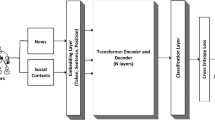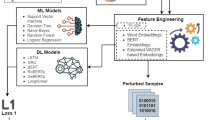Abstract
On the Internet, fake news exists in various domain (e.g., education, health). Since news in different domains has different features, researchers have begun to use single domain label for fake news detection recently. Existing works show that using single domain label can improve the accuracy of fake news detection model. However, there are two problems in previous works. Firstly, they ignore that a piece of news may have features from different domains. The single domain label focuses only on the features of one domain. This may reduce the performance of the model. Secondly, their model cannot transfer the domain knowledge to the other dataset without domain label. In this paper, we propose a novel model, FuDFEND, which solves the limitations above by introducing the fuzzy inference mechanism. Specifically, FuDFEND utilizes a neural network to fit the fuzzy inference process which constructs a fuzzy domain label for each news item. Then, the feature extraction module uses the fuzzy domain label to extract the multi-domain features of the news and obtain the total feature representation. Finally, the discriminator module uses the total feature representation to discriminate whether the news item is fake news. The results on the Weibo21 show that our model works better than the model using only single domain label. In addition, our model transfers domain knowledge better to Thu dataset which has no domain label.
Access this chapter
Tax calculation will be finalised at checkout
Purchases are for personal use only
Similar content being viewed by others
References
Tavernise, S.: As fake news spreads lies, more readers shrug at the truth. The New York Times. Accessed 26 Jan 2017
Rawat, M., Kanojia, D.: Automated Evidence Collection for Fake News Detection. arXiv:2112.06507 (2021)
Hangloo, S., Arora, B.: Fake news detection tools and methods — a review. Int. J. Adv. Innovat. Res. 8(2) (IX), 100–108 (2021)
Mouratidis, D., Nikiforos, M.N., Kermanidis, K.L.: Deep learning for fake news detection in a pairwise textual input schema. Computation 9(2), 20 (2021)
Pérez-Rosas, V., Kleinberg, B., Lefevre, A., et al.: Automatic detection of fake news. In: Association for Computational Linguistics, pp. 3391–3401 (2017)
Castillo, C., Mendoza, M., Poblete, B.: Information credibility on Twitter. In: WWW, pp. 675–684 (2011)
Jin, Z., Cao, J., Guo, H., Zhang, Y., Wang, Y., Luo, J.: Detection and analysis of 2016 US presidential election related rumors on Twitter. In: Lee, D., Lin, Y.-R., Osgood, N., Thomson, R. (eds.) SBP-BRiMS 2017. LNCS, vol. 10354, pp. 14–24. Springer, Cham (2017). https://doi.org/10.1007/978-3-319-60240-0_2
Kwon, S., et al.: Prominent Features of Rumor Propagation in Online Social Media, pp. 1103–1108. IEEE (2013)
Ma, B., Lin, D., Cao, D.: Content representation for microblog rumor detection. In: Angelov, P., Gegov, A., Jayne, C., Shen, Q. (eds.) Advances in Computational Intelligence Systems. AISC, vol. 513, pp. 245–251. Springer, Cham (2017). https://doi.org/10.1007/978-3-319-46562-3_16
Ma, J., et al.: Detecting rumors from microblogs with recurrent neural networks. IJCA. 3818–3824 (2016)
Nan, Q., et al.: MDFEND: Multi-domain Fake News Detection, pp. 3343–3347. ACM (2022)
Hakak, S., Alazab, M., Khan, S., Gadekallu, T.R., Maddikunta, P.K.R., Khan, W.Z.: An ensemble machine learning approach through effective feature extraction to classify fake news. Futur. Gen. Comput. Syst. 117, 47–58 (2021)
Potthast, M., Kiesel, J., Reinartz, K., et al.: A stylometric inquiry into hyperpartisan and fake news. In: Association for Computational Linguistics, pp. 231–240 (2018)
Jin, Z., Cao, J., Zhang, Y., et al.: Novel visual and statistical image features for microblogs news verification. IEEE Trans. Multim. 19(3), 598–608 (2016)
Alonso-Bartolome, S., Segura-Bedmar, I.: Multimodal Fake News Detection. arXiv:2112.04831 (2021)
Jin, Z.W., et al.: Multimodal Fusion with Recurrent Neural Networks for Rumor Detection on Microblogs, pp. 795–816. ACM (2017)
Qi, P., Cao, J., Yang, T., et al.: Exploiting Multi-domain Visual Information for Fake News Detection, pp. 518–527. IEEE (2019)
Kaist, K.S., Kaist, C.M., Snu, J.K.: Rumor detection over varying time windows. PLoS ONE 12(1), e0168344 (2017)
Shu, K., Wang, S., Liu, H.: Beyond News Contents: The Role of Social Context for Fake News Detection, pp. 312–320. ACM (2019)
Alrubaian, M., et al.: A credibility analysis system for assessing information on Twitter. IEEE Trans. Dependab. Secure Comput. 15(4), 661–674 (2016)
Jacob, D., et al.: BERT: pre-training of deep bidirectional transformers for language understanding. In: Association for Computational Linguistics, pp. 4171–4186 (2019)
Cui, Y., et al.: Revisiting Pre-trained Models for Chinese Natural Language Processing. In: Association for Computational Linguistics, pp. 657–668 (2020)
Zadeh, L.A.: Fuzzy sets. Inf. Control 8(3), 338–353 (1965)
Jacobs, R.A., Jordan, M.I., Nowlan, S.J., Hinton, G.E.: Adaptive mixtures of local experts. Neural Comput. 3(1), 79–87 (1991)
Ma, J., Zhao, Z., Yi, X., et al.: Modeling Task Relationships in Multi-task Learning With Multi-gate Mixture-of-Experts, pp. 1930–1939. ACM (2018)
Zhu, Y., Liu, Y., Xie, R., et al.: Learning to Expand Audience via Meta Hybrid Experts and Critics for Recommendation and Advertising, pp. 4005–4013. ACM (2021)
Kim, Y.: Convolutional neural networks for sentence classification. In: Empirical Methods in Natural Language Processing (EMNLP), pp. 1746–1751 (2014)
Liu, Z.Y., Zhang, L., Cunchao, T.U., et al.: Statistical and semantic analysis of rumors in Chinese social media. Sci. Sin. Inf. 45(12), 1536–1546 (2015)
Song, C., Tu, C., Yang, C., et al.: CED: credible early detection of social media rumors. IEEE Trans. Knowl. Data Eng. 33(8), 3035–3047 (2018)
Kingma, D., Ba, J.: Adam: a method for stochastic optimization. Comput. Sci. arXiv preprint arXiv:1412.6980 (2014)
Author information
Authors and Affiliations
Corresponding author
Editor information
Editors and Affiliations
Rights and permissions
Copyright information
© 2022 Springer Nature Switzerland AG
About this paper
Cite this paper
Liang, C., Zhang, Y., Li, X., Zhang, J., Yu, Y. (2022). FuDFEND: Fuzzy-Domain for Multi-domain Fake News Detection. In: Lu, W., Huang, S., Hong, Y., Zhou, X. (eds) Natural Language Processing and Chinese Computing. NLPCC 2022. Lecture Notes in Computer Science(), vol 13552. Springer, Cham. https://doi.org/10.1007/978-3-031-17189-5_4
Download citation
DOI: https://doi.org/10.1007/978-3-031-17189-5_4
Published:
Publisher Name: Springer, Cham
Print ISBN: 978-3-031-17188-8
Online ISBN: 978-3-031-17189-5
eBook Packages: Computer ScienceComputer Science (R0)





